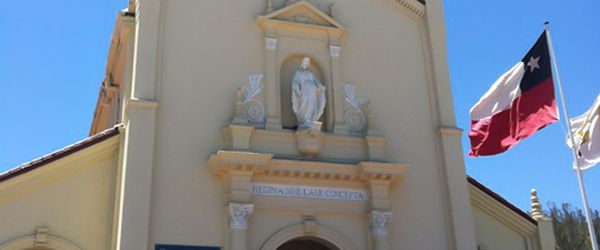Located in an air pollution ‘hot spot,’ Resurrection School participates in AQMD documentary.
A drawing titled “Angry Birds” adorning an auditorium wall at Resurrection School well depicted the critical situation faced daily by East Los Angeles residents.
“I get angry when people pollute,” a bird with an angry face is telling another one while flying towards what seems a factory chimney expelling smoke, in the drawing created by fourth-grader Cristian Figueroa.
Resurrection students were asked to illustrate what they have learned in the classroom and what they perceive as the effects of the poor air quality in their residence area and its consequences.
Some of the drawings were used in the documentary film “The Right to Breathe,” produced by Diamond Bar-based South Coast Air Quality Management District to raise awareness of the health effects of air pollution in certain areas of Southern California, including downtown L.A., and to inspire families to get involved in air quality solutions.
Officials say air quality is better compared to 50 years ago when cars sometimes crashed on the freeway because air was so thick it was difficult for drivers to see a few feet ahead. But there is still much to be done, especially at the ports (Long Beach and L.A.), close to train tracks, and with all carbon-emission vehicles and factories.
“The Right to Breathe,” directed by award-winning filmmaker Alexandre Philippe, was presented Jan. 18 to the student body, faculty and staff. It includes stories and interviews with people from all walks of life, including Msgr. John Moretta, Resurrection’s pastor, who said “clean air is certainly a right; a matter of justice.
“I think the tragedy is when certain communities because of their income background or because they may not have the same education are taken for granted,” said Msgr. Moretta in the documentary, who added that religious communities can play a “great role in keeping the environment clean.”
“We wake up in the morning and usually in California there is a blue sky,” he said, “but we don’t really understand that there are places --- hot spots --- and where I am right now in Boyle Heights is one of those places where the air is not that good.”
About 5,000 Southern Californians die prematurely each year due to air pollution, according to data provided in the documentary, and 15 people die daily from pollution-related illnesses.
“Pollution affects lung growth and causes asthma,” Dr. Elisa Nicholas, chief executive officer of the Children’s Clinic in Los Angeles, declares in the film. “We see at our clinic children who are suffering from asthma and many of them have asthma that is not under control.”
“If people keep doing this stuff we won’t be able to breathe and it will be hard for us to live our lives,” says a young Resurrection student on the movie. His drawing showed factories with black smoke pouring out, the sentence “Don’t kill the Earth,” and a tree screaming, “Help!”
“And if we can’t live for our lives,” he adds, “then we can’t start a new generation.”
Principal Angelica Figueroa said it has been a permanent goal to ingrain in the students the philosophy of the school’s patron, St. Francis of Assisi. Staffed by the Franciscan Sisters of Mary Immaculate, Resurrection School encourages and educates the children about the relationship between creation and saving the environment in which they live, Figueroa said.
That is why when the school and the church were approached two years ago by the AQMD to do an on-campus study on pollution, and as a way to “voice community concerns” in a fight for environmental justice, they immediately established a partnership.
An aluminum can recycling program, organic vegetable gardens planted by students, paper recycling in each classroom, and trash pick-up monitoring were among the programs established in collaboration with parents.
At the end of the Jan. 18 presentation, students were offered additional ideas for saving energy and water at home and school: turning off lights and computers, taking shorter showers and less time to brush their teeth, and keeping the refrigerator closed.
Asked what the film taught her, third grade student Sunem Mares, 8, replied, “We have to breathe perfect, and for that we need to stop cutting trees.”
Fifth-grader Joseph Delgado said he learned that his family can use the leftovers of every meal to “make rich soil for the plants.”
Sixth-grader Samantha Ambrice said her father recycles the water bottles used at home, which she believes helps the community as well.
Starting in February, “The Right to Breathe” will air on KLCS-TV, content provider for the L.A. Unified School District. To watch the documentary go to www.therighttobreathe.org.
{gallery width=100 height=100}gallery/2012/0127/resurrection/{/gallery}

